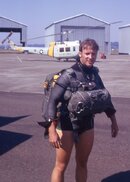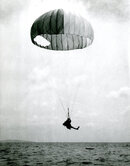I took one other precaution. I attached a strap to the mouthpiece to make sure that in case of "blackout" it could not be lost. THe thought of passing out and drowning in the closed tank before they could open the hatch was not pleasant. Later you will note that this was not a wasted effort...
..."I braced for the ascent. As I looked around the chamber I remember thinking 'It's all over now' and mentally patting myself onthe back. I still thought I was somewhere around 360 feet, since that was where I last saw the needle on the depth gauge when I moved to the ladder. THEN THERE WAS NOTHING! The men outside saw that my head was bowed. My muscles twitched violently as I hung onto the ladder. The pressure gauge read 165 pounds per square inch, the last pressure reading recorded by the tape recorder--a pressure equivalent to that experienced at a depth of 380 feet.
"The descent had taken eight and a hulf minutes from the surface and 30 seconds on the bottom for a total dive of 9 minutes duration. I remmmber very little of the many things that went through my mind. I was apparently "out" but I do remember having what seemed to be dreams. At first there was a total blackout. Then a vague sence of consciousness. I would never care to have the feelings of that half-world of unreality again.
"MY BLACKOUT CAME WITH ABSOLUTELY NO WARNING. There was no physical unpleasantness connected with it--I was conscuious one monment, and unconscious the next.
"As I began to wake up I remember two incidents which occurred during my semi-conscious state. The first may have been the factor that resulted in the death of Diving Master Maurcie Fargues, a member of Captain J. Y. Counstea's diving team, who descended to the remarkable depth of 396 feet. This also may havecost a Miami attorney, hope Root, his life on his 400 foot air dive, from which he never returned.
"For some reason, all at once I could not seem to get enough air to breathe. My lungs felt as though they were on fire and I had the urge to open my mouth wide and take deep breaths. Fortunately this sensation apparently did not last too long, and I had fastened my mouthpiece around my head and in my mouth so hard that the corners of mouth were stretched over the edges, and this would not possible allow me to pen my mouth. Finally the sensation was gone and I could breathe easily again.
"The body of Diving Master Maurice Fargus was recovered via a lif line with his mouthpiece hanging at is ches. Perhaps he too felt the urge to open his mouth wide nad found only water to inhale. He died of drowning. No one can say what happened to Root since Sonar lost him at 400 feet in 600 feet of water...






